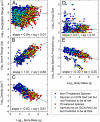Multiple ecological pathways to extinction in mammals
- PMID: 19528635
- PMCID: PMC2705575
- DOI: 10.1073/pnas.0901956106
Multiple ecological pathways to extinction in mammals
Abstract
As human population and resource demands continue to grow, biodiversity conservation has never been more critical. About one-quarter of all mammals are in danger of extinction, and more than half of all mammal populations are in decline. A major priority for conservation science is to understand the ecological traits that predict extinction risk and the interactions among those predictors that make certain species more vulnerable than others. Here, using a new database of nearly 4,500 mammal species, we use decision-tree models to quantify the multiple interacting factors associated with extinction risk. We show that the correlates of extinction risk vary widely across mammals and that there are unique pathways to extinction for species with different lifestyles and combinations of traits. We find that risk is relative and that all kinds of mammals, across all body sizes, can be at risk depending on their specific ecologies. Our results increase the understanding of extinction processes, generate simple rules of thumb that identify species at greatest risk, and highlight the potential of decision-tree analyses to inform conservation efforts.
Conflict of interest statement
The authors declare no conflict of interest.
Figures




References
-
- Jones KE, Purvis A, Gittleman JL. Biological correlates of extinction risk in bats. Am Nat. 2003;161(4):601–613. - PubMed
-
- Cardillo M. Biological determinants of extinction risk: Why are smaller species less vulnerable? Anim Conservation. 2003;6:63–69.
-
- Cardillo M, et al. Multiple causes of high extinction risk in large mammal species. Science. 2005;309:1239–1241. - PubMed
-
- McKenzie NL, et al. Analysis of factors implicated in the recent decline of Australia's mammal fauna. Journal of Biogeography. 2007;34:597–611.
Publication types
MeSH terms
LinkOut - more resources
Full Text Sources
Research Materials

